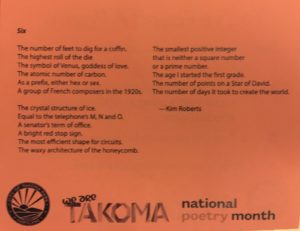The site of a thriving literary tradition, Washington, DC, has been the home to many of our nation’s most acclaimed writers. From the city’s founding to the beginnings of modernism, literary luminaries including Walt Whitman, Paul Laurence Dunbar, Alice Dunbar-Nelson, Henry Adams, Langston Hughes, and Zora Neale Hurston have lived and worked at their craft in our nation’s capital.
In A Literary Guide to Washington, DC, Kim Roberts offers a guide to the city’s rich literary history. Part walking tour, part anthology, A Literary Guide to Washington, DC is organized into five sections, each corresponding to a particularly vibrant period in Washington’s literary community. Starting with the city’s earliest years, Roberts examines writers such as Hasty-Pudding poet Joel Barlow and “Star-Spangled Banner” lyricist Francis Scott Key before moving on to the Civil War and Reconstruction and touching on the lives of authors such as Charlotte Forten Grimké and James Weldon Johnson. She wraps up her tour with World War I and the Jazz Age, which brought to the city some writers at the forefront of modernism, including the first American to win the Nobel Prize for Literature, Sinclair Lewis. The book’s stimulating tours cover downtown, the LeDroit Park and Shaw neighborhoods, Lafayette Square, and the historic U Street district, bringing the history of the city to life in surprising ways.
Written for tourists, literary enthusiasts, amateur historians, and armchair travelers, A Literary Guide to Washington, DC offers a cultural tour of our nation’s capital through a literary lens.
Reviews
“It is easy to feel like a second-class citizen in Washington, D.C. when it comes to our literary heritage. Washington is not commonly associated with a national recognized literary movement such as Transcendentalists in Boston or Beat Poets in Greenwich Village and San Francisco…But what D.C.’s literary tradition has existed all along, patiently awaiting a champion to identify who and what has been hiding in plain sight? Enter literary historian, writer, and editor Kim Roberts, whose A Literary Guide to Washington, DC shines a light on the work of American writers who lived and wrote in the nation’s capital between 1800 and 1930. Roberts’s book proves beyond a doubt that Washington has a proud literary legacy to celebrate and cherish.”
—Carolyn Crouch, Washington History, Vol. 31, Nos. 1 & 2, Fall 2019
“Roberts has expert knowledge of the former residences of literary figures in D.C., like the Douglas Johnson house. Upon her arrival to the city, she immediately started researching the topic, primarily focusing on the homes of Walt Whitman, one of her favorite authors. She and fellow poet and friend Dan Vera developed a hobby of going to the former addresses of writers to see if the buildings were still standing. ‘You could say I’ve been writing this book for a really long time,’ Roberts says of A Literary Guide to Washington DC, ‘but I didn’t know that it was a book.’”
—Ella Feldman, Washington City Paper, October 24, 2019
“District resident Kim Roberts, a poet and literary historian, has compiled this unique guide that can expand your mind as you exercise your body. Follow four walking tours to the residences and places of interest in the lives and times of D.C.’s greatest writers, their spouses and social acquaintances.”
—Dinah Rokach, The Beacon Newspapers, October 8, 2019
“It’s not often that a literary history comes alive by inviting the reader to walk around and experience where prominent writers wrote…A pleasing layout makes the book easy to read, especially if the reader is on the street trying to understand why the destination has been singled out for literary tribute…Lots of historic nuggets to mine in Kim Roberts’s A Literary Guide to Washington, DC.”
—Karren LaLonde Alenier, Scene4 Magazine, Volume 19, Issue 6, November 2018
“Writer and literary historian Kim Roberts had been working on her most recent book, A Literary Guide to Washington, D.C., for years before she even knew she was writing a book. When Roberts moved to the nation’s capital 30 years ago, she began researching writers who had lived in the city in years prior. Roberts was disappointed at how few of these places talked about the writers who inhabited them, and began to map the lives of famous wordsmiths like Walt Whitman and Langston Hughes in their forays about the District. ‘I’ve always been really attracted to a sense of place,’ Roberts explained in a recent interview, saying that documenting the places these writers lived and worked ‘made the city come alive in a new way.’ Her research cumulated in this pocket-sized guidebook to the city, a collection of spotlights on historic places related to D.C.’s cultural scene, accompanied by short biographies of writers connected to Washington and four walking tours readers can follow. The book represents an impressive cross-section of writers from a variety of historical periods, ethnicities, and backgrounds.”
—Rebecca Gale, “Mr. Whitman Goes to Washington,” Preservation Magazine, August 8, 2018, National Trust for Historic Preservation
“Four walking tours take you where famous authors lived, worked, and partied. Learn about Walt Whitman’s experience tending injured Civil War soldiers or stop by the house where Langston Hughes, Zora Neale Hurston, and other luminaries met for salons.”
—Washingtonian Magazine, August 2018 Issue
“The author, Kim Roberts, is a literary historian, which shows in the broad array of authors she mentions in this handy and engaging book full of photos and quotations. Walt Whitman and Henry Adams are here, of course, but also old writers who may be new to many readers, starting with the poet Joel Barlow (1754-1812). Roberts’s walking directions are easy to follow, but her tales of writers in the capital are so engaging that readers may feel they don’t even need to leave the house.”
—Ron Charles, Book Reviewer for The Washington Post, July 13, 2018
“Kim Roberts wrote the book on D.C. authors. She had to, because she felt the district hasn’t gotten its due as a literary city. ‘D.C. has never really had that identity, despite the fact that we’ve had so many important writers live here,’ says Roberts…’When I moved here 30 years ago, I wanted to know who they were and where they lived. It gave me a deeper sense of ownership of place.’ So she started offering walking tours that include stops like ‘Newspaper Row’ on 14th Street, and eventually decided to turn her extensive knowledge into a cultural tour of a book.”
—Washington Post Express, June 28, 2018
“Kim Roberts’ latest leads readers through the literary—and literal—landscape of the nation’s capital and reveals the city’s rich history in letters…Roberts’ literary guide is definitely one to pick up for those interested in Washington history, American literature between 1800 and 1930, African-American literature or even generally in the interplay between artists, their landscapes and their moments in history.”
—The DC Line, June 27, 2018
“As Kim Roberts writes in her eloquent introduction to A Literary Guide to Washington, DC, writers here have often chafed against the perception that ‘government is DC’s only business.’ Her well-reseached book should put paid to that notion…A Literary Guide to Washington, DC is an invaluable resource.”
—The Hill Rag, June 2018
“The perfect accompaniment for a literature-inspired vacation in the U.S. capital. The compact size, clearly labeled maps, and succinct, informative text make this a handy guide to slip into your suitcase.”
—Library Journal, May 2018
 Selected by the DC Public Libraries for the 2021
Selected by the DC Public Libraries for the 2021 



 Corona/Crown
Corona/Crown